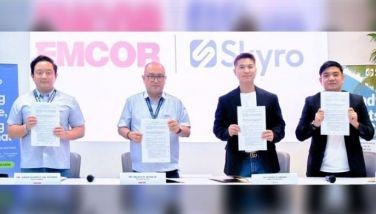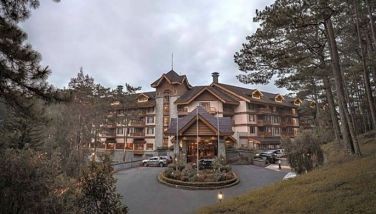Math and aftermath
August 24, 2006 | 12:00am
Many years ago while taking an electrical engineering class at the University of the Philippines in Diliman, I was thoroughly impressed by my professor, Bartolome Blanco, who solved a differential equation with initial conditions by some sort of a "trick." He called his trick the Laplace transform.
With thirty-some bright-eyed classmates agog at learning new ideas, I was wondering if he was pulling our legs. Ever quick on the uptake, Prof. Blanco said, "If any of you wish to impugn what I taught here, you can check out my solution by plugging it into the equation or you can run to the Math Department to see what was going on."
Wow! Some of us had brushed elbows with the simplest differential equations, never heard of transforms, except in reference to converting high voltage to low voltage in AC circuits. And "impugn"? I had read that word somewhere in a long forgotten book but that was the first time I heard it used. Now you understand why I was impressed with my "Prof" and had visions of following in his footsteps.
So much so that I jumped on the opportunity to teach engineering at UP upon my graduation, when Dean C. Ortigas offered me an instructorship. At the same time, I took more math classes on the side: a class on differential equations here, a class on advanced engineering math there. It certainly gave me a step up when UP later sent me abroad for graduate studies.
Now fast forward to what I ended up doing. My doctoral dissertation at the State University of New York at Stony Brook was on the Hankel transformation of generalized functions with applications to sorts of differential equations. This is really a mouthful and I am going too far ahead of myself. With your indulgence, let me start from scratch.
1. Mathematics is the study of relations and their properties. A relation is a correspondence between two sets of objects. These objects can be anything: numbers, figures, sets, or even relations, too. When the correspondence assigns a unique object from the second set to each element of the first set, we call that relation a function. A function is usually restricted to a relation between sets of numbers. If the relation is between sets of functions, we call it an operator. If the relation is from a set of functions to a set of numbers, we call it a functional. Here are some examples.
Functions: linear, quadratic, rational, exponential, trigonometric, special.
Operators: differential operator - d/dx, integral operator- º…dx.
Functionals: definite integrals, Dirac delta.
2. Calculus is a branch of math dealing with change. The rate of change of a function f is its derivative f’ and the process of finding the derivative is called differentiation. Because our world is always in a state of flux, processes, natural or otherwise, can be described by equations involving derivatives. These are called differential equations, which are creatures more intractable than algebraic equations. Their solutions are functions while the latter has numbers for solutions. For example:
Algebraic equation: x square +4x+3=0 is solved by x = -1 or x = -3.
Differential equation: y"+4y’+3y=0 is solved by y=a[exp(-x)]+b[exp(-3x)], a & b constants.
The last equation describes a simple damped spring mass system or a simple electric circuit with a battery, a capacitor and a resistance and the solution is a combination of two decaying exponential functions. The solution is found by the observation that an exponential function replicates itself on differentiation. Thus the task is reduced to solving an algebraic equation. More complicated equations are solved by such techniques as infinite series, integral transformation, Fourier series, special functions and numerical methods and computer codes.
3. An integral transformation is an operator that takes a set of functions and maps it into a set of transforms via integration. The most famous is the Laplace transform given by F(s) = L[f(t)] = ºexp(-st)f(t)dt with the important property L[f’(t)] = sL[f(t)] — f(0). Thus when f(0) = 0, differentiation corresponds to multiplication by s in the transform domain. The Laplace transform has been used to justify Heaviside’s calculus used by engineers. The term exp(-st) is called the kernel of the transform. By changing the kernel as well as the range of integration, other integral transforms were developed and used for solving other equations. The Hankel transform replaces exp(-st) with Ãst Jµ(st) where Jµ(st) is Bessel function of order µ. This transform is suitable for differential equations with variable coefficients that arise in physical problems with axial symmetry. Other transforms go by such names as Fourier, Weierstrass, Stieltjes, Meijer, Hilbert, Jacobi, convolution, etc., each with its suitability for certain differential operators. The definitions, properties and applications are enough to fill several books.
4. In 1926, Dirac introduced his d-function as d(x)=0 when xÂÂ0, ºf(x) d(a-x)dx=f(a) and used it in quantum mechanics. This is not a function in the classical sense. To be sure there were other improper functions such as Hadamard’s pseudofunction pf x, Cauchy’s pv of a divergent integral, derivatives of Dirac- dthat have appeared in some physicists’ works. In the 1950s, Laurent Schwartz came up with his Theory of Distributions to explain all these as continuous linear functionals on test functions with compact supports. In the ‘60s, the Russians Gelfand and Shilov came up with their four-volume treatise on Generalized Functions not drastically different from Schwartz.
5. In the ’60s and ’70s, Armen Zemanian and others developed various integral transformations of generalized functions (gfs). Zemanian and I developed the generalized Hankel transform under some restrictions. Later, I went farther than our work going into representations of Hankel transforms, transforms of negative orders, transforms in higher dimensions. I later developed the generalized Meijer transform (with my student M. Ali), Hankel Transforms of Banach-space-valued gfs (with my student C. K. Li).
6. There are two methods of extending the integral transformation to generalized functions. The Adjoint Method uses a Parseval—type relation to define the transform of a gf F as the application of F on the transform of a suitable test function. Schwartz used this method for the Fourier transform, Gelfand and Shilov for the Hilbert transform, Zemanian for the Hankel and other transforms. What’s involved is the construction of two test function spaces such that one is the transform of the other. Details can be found in their books.
The other method defines the transform as the application of the generalized function F on the kernel as an element of a test function space. This necessitates the construction of a suitable complete semi-normed space that contains the kernel. Zemanian used this method for the Laplace transform and I did it for the Hankel transform. Details may be found in Zemanian’s book and Brychkov and Prudnikov (1998).
The University of the Philippines is a great source of inspiration for our youth despite its lack of material resources. It is, however, rich in a faculty that is a fountain of wisdom and knowledge. I credit Prof. Blanco in igniting a spark to my career. But there were many excellent professors I had. I would be remiss not to acknowledge Professor Josefina Constantino who instilled in me a love of the English language. From the time I became Professor Emeritus in 1999, I have published short stories, poems and essays online and in print. In these writings my math background seems to creep in.
American poet Adelaide Crapsey invented a verse form in the 1920s called cinquain, which is a poem of five iambic lines of two, four, six, eight and two syllables. There are no restrictions on rhyme but there is a central theme in the cinquain. In 1927, Angela M. Gloria published three cinquains in the Philippine Herald. Here are some unpublished cinquains of mine on scientists:
Newton
The man
Felt the apple
Dropped on his head with such
Gravity, he couldn’t help yell,
"Aha!"
Einstein
He did
Tinker with his
Relatives; speed boggles
The mind as energy and mass
Equate.
Archimedes
He ran
Out in the buff
Hollering "Eureka!"
For he had found that buoyant force
Pushed up.
Leibniz
Symbols
He used for thoughts,
Logic was the richer,
And calculus was brought to the
Limit.
Dr. Eusebio (Seb) L. Koh has been a professor emeritus of mathematics at the University of Regina since 1999. He has taught mechanical engineering and mathematics in the Philippines, the United States, Canada, Germany and Saudi Arabia. He holds master’s degrees from Purdue University and the University of Birmingham in England and a Ph.D. from SUNY, Stony Brook. He has published over 50 refereed research papers in mathematics and sundry articles in engineering. He has given lectures and conference seminars in the Philippines, other Asian countries, North America and Europe. Since his retirement from university teaching, he has published short stories and poems in Our Own Voice, The Best Philippine Short Stories and the Prairie Messenger, the Catholic weekly in Saskatchewan. Since 1993, he writes a column for Filipino Journal, a Philippine semi-monthly in Winnipeg. When not writing, he is into chess, tennis, crossword and Sudoku puzzles, volunteer church work, Knights of Columbus or learning to cook. E-mail at [email protected].
With thirty-some bright-eyed classmates agog at learning new ideas, I was wondering if he was pulling our legs. Ever quick on the uptake, Prof. Blanco said, "If any of you wish to impugn what I taught here, you can check out my solution by plugging it into the equation or you can run to the Math Department to see what was going on."
Wow! Some of us had brushed elbows with the simplest differential equations, never heard of transforms, except in reference to converting high voltage to low voltage in AC circuits. And "impugn"? I had read that word somewhere in a long forgotten book but that was the first time I heard it used. Now you understand why I was impressed with my "Prof" and had visions of following in his footsteps.
So much so that I jumped on the opportunity to teach engineering at UP upon my graduation, when Dean C. Ortigas offered me an instructorship. At the same time, I took more math classes on the side: a class on differential equations here, a class on advanced engineering math there. It certainly gave me a step up when UP later sent me abroad for graduate studies.
Now fast forward to what I ended up doing. My doctoral dissertation at the State University of New York at Stony Brook was on the Hankel transformation of generalized functions with applications to sorts of differential equations. This is really a mouthful and I am going too far ahead of myself. With your indulgence, let me start from scratch.
1. Mathematics is the study of relations and their properties. A relation is a correspondence between two sets of objects. These objects can be anything: numbers, figures, sets, or even relations, too. When the correspondence assigns a unique object from the second set to each element of the first set, we call that relation a function. A function is usually restricted to a relation between sets of numbers. If the relation is between sets of functions, we call it an operator. If the relation is from a set of functions to a set of numbers, we call it a functional. Here are some examples.
Functions: linear, quadratic, rational, exponential, trigonometric, special.
Operators: differential operator - d/dx, integral operator- º…dx.
Functionals: definite integrals, Dirac delta.
2. Calculus is a branch of math dealing with change. The rate of change of a function f is its derivative f’ and the process of finding the derivative is called differentiation. Because our world is always in a state of flux, processes, natural or otherwise, can be described by equations involving derivatives. These are called differential equations, which are creatures more intractable than algebraic equations. Their solutions are functions while the latter has numbers for solutions. For example:
Algebraic equation: x square +4x+3=0 is solved by x = -1 or x = -3.
Differential equation: y"+4y’+3y=0 is solved by y=a[exp(-x)]+b[exp(-3x)], a & b constants.
The last equation describes a simple damped spring mass system or a simple electric circuit with a battery, a capacitor and a resistance and the solution is a combination of two decaying exponential functions. The solution is found by the observation that an exponential function replicates itself on differentiation. Thus the task is reduced to solving an algebraic equation. More complicated equations are solved by such techniques as infinite series, integral transformation, Fourier series, special functions and numerical methods and computer codes.
3. An integral transformation is an operator that takes a set of functions and maps it into a set of transforms via integration. The most famous is the Laplace transform given by F(s) = L[f(t)] = ºexp(-st)f(t)dt with the important property L[f’(t)] = sL[f(t)] — f(0). Thus when f(0) = 0, differentiation corresponds to multiplication by s in the transform domain. The Laplace transform has been used to justify Heaviside’s calculus used by engineers. The term exp(-st) is called the kernel of the transform. By changing the kernel as well as the range of integration, other integral transforms were developed and used for solving other equations. The Hankel transform replaces exp(-st) with Ãst Jµ(st) where Jµ(st) is Bessel function of order µ. This transform is suitable for differential equations with variable coefficients that arise in physical problems with axial symmetry. Other transforms go by such names as Fourier, Weierstrass, Stieltjes, Meijer, Hilbert, Jacobi, convolution, etc., each with its suitability for certain differential operators. The definitions, properties and applications are enough to fill several books.
4. In 1926, Dirac introduced his d-function as d(x)=0 when xÂÂ0, ºf(x) d(a-x)dx=f(a) and used it in quantum mechanics. This is not a function in the classical sense. To be sure there were other improper functions such as Hadamard’s pseudofunction pf x, Cauchy’s pv of a divergent integral, derivatives of Dirac- dthat have appeared in some physicists’ works. In the 1950s, Laurent Schwartz came up with his Theory of Distributions to explain all these as continuous linear functionals on test functions with compact supports. In the ‘60s, the Russians Gelfand and Shilov came up with their four-volume treatise on Generalized Functions not drastically different from Schwartz.
5. In the ’60s and ’70s, Armen Zemanian and others developed various integral transformations of generalized functions (gfs). Zemanian and I developed the generalized Hankel transform under some restrictions. Later, I went farther than our work going into representations of Hankel transforms, transforms of negative orders, transforms in higher dimensions. I later developed the generalized Meijer transform (with my student M. Ali), Hankel Transforms of Banach-space-valued gfs (with my student C. K. Li).
6. There are two methods of extending the integral transformation to generalized functions. The Adjoint Method uses a Parseval—type relation to define the transform of a gf F as the application of F on the transform of a suitable test function. Schwartz used this method for the Fourier transform, Gelfand and Shilov for the Hilbert transform, Zemanian for the Hankel and other transforms. What’s involved is the construction of two test function spaces such that one is the transform of the other. Details can be found in their books.
The other method defines the transform as the application of the generalized function F on the kernel as an element of a test function space. This necessitates the construction of a suitable complete semi-normed space that contains the kernel. Zemanian used this method for the Laplace transform and I did it for the Hankel transform. Details may be found in Zemanian’s book and Brychkov and Prudnikov (1998).
The University of the Philippines is a great source of inspiration for our youth despite its lack of material resources. It is, however, rich in a faculty that is a fountain of wisdom and knowledge. I credit Prof. Blanco in igniting a spark to my career. But there were many excellent professors I had. I would be remiss not to acknowledge Professor Josefina Constantino who instilled in me a love of the English language. From the time I became Professor Emeritus in 1999, I have published short stories, poems and essays online and in print. In these writings my math background seems to creep in.
American poet Adelaide Crapsey invented a verse form in the 1920s called cinquain, which is a poem of five iambic lines of two, four, six, eight and two syllables. There are no restrictions on rhyme but there is a central theme in the cinquain. In 1927, Angela M. Gloria published three cinquains in the Philippine Herald. Here are some unpublished cinquains of mine on scientists:
Newton
The man
Felt the apple
Dropped on his head with such
Gravity, he couldn’t help yell,
"Aha!"
Einstein
He did
Tinker with his
Relatives; speed boggles
The mind as energy and mass
Equate.
Archimedes
He ran
Out in the buff
Hollering "Eureka!"
For he had found that buoyant force
Pushed up.
Leibniz
Symbols
He used for thoughts,
Logic was the richer,
And calculus was brought to the
Limit.
BrandSpace Articles
<
>
- Latest
Latest
Latest
October 25, 2024 - 9:00am
October 25, 2024 - 9:00am
October 24, 2024 - 11:20am
October 24, 2024 - 11:20am
October 14, 2024 - 11:00am
October 14, 2024 - 11:00am
October 11, 2024 - 12:49pm
October 11, 2024 - 12:49pm
September 30, 2024 - 8:00am
September 30, 2024 - 8:00am
September 26, 2024 - 2:00pm
September 26, 2024 - 2:00pm
Recommended
February 16, 2025 - 12:00am
February 15, 2025 - 12:00am

























